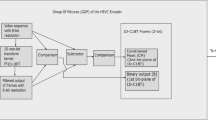Abstract
Frequent table look-up can result in high memory access, and high memory access can cause increased power consumption in CAVLC decoding. Aiming to solve the problem of high table memory access during the process of CAVLC decoding for H.264/AVC due to frequent table look-up, thereby reducing the power consumption, a high-efficient table memory access saving algorithm is presented in this paper. The contribution of the proposed scheme is that we use program code to instead of the conventional table look-up method that requires a lot of memory access. In our scheme, we use program code to realize fully the expression of all the UVLT (Unstructured Variable Length Tables) in CAVLC decoding, as a result, all the decoded codewords in UVLT can be obtained easily through a program execution way instead of sequential table look-up. which can save a lot of memory access and power consumption due to without looking up UVLT in CAVLC decoding, The simulation results show that our proposed scheme can save 100 % memory access of table look-up for CAVLC decoding compared with TLSS method due to the use of program code, thereby saving much power consumption, without degrading video quality.








Similar content being viewed by others
References
Draft Text of H.264/AVC Advanced 4:4:4 Profile Amendment to ITU-T Rec.H.264/ISO/IEC 14496–10 AVC, document JVT-Q209.doc, Joint Video Team of ISO/IEC JTC1/SC29/WG11 and ITU-T Q.6/SG16, Oct. 2005
Joint Video Team (JVT) of ISO/IEC MPEG & ITU-T VCEG, Draft ITU-T Recommendation and Final Draft International Standard of Joint Video Specification (ITU-T Rec.H.264|ISO/IEC14496-10 AVC), Doc. G050r1, Mar. 2003
Luthra, A., Sullivan, G.J., Wiegand, T.: Introduction to the special issue on the H.264/AVC video coding standard. IEEE Trans. Circuits Syst. Video Technol. 13(7), 557–559 (2003)
Sullivan, G.J., Wiegand, T.: Video compression: from concepts to the H.264/AVC standard. Proc. IEEE 93(1), 18–31 (Jan. 2005)
Editors’ draft revision to ITU-T Rec. H.264 | ISO/IEC 14496–10 Ad-vanced Video Coding-in preparation for ITU-T SG 16 AAP Consent, document JVT-AD205.doc, Joint Video Team of ISO/IEC 14496–10 AVC, ISO/IEC JTC1/SC29/WG11, and ITU-T Q.6/SG16 (2009)
ITU-T Recommendation H.264. Advanced video coding for generic audiovisual services. ITU-T (2005)
Wiegand, T., Sullivan, G., Bjontegaard, G.: Overview of the H.264/AVC Video coding standard. IEEE Trans. CSVT 13(7), 560–576 (2003)
Chen, Yanling, Cao, Xixin, Peng, Xiaoming, et al.: A memory-efficient CAVLC decoding scheme for H.264/AVC. In: 10th International Conference on Advanced Communication Technology. ICACT 2, 1135–1138 (2008)
Paver, N.C., Aldrich, B.C., Khan, M.H.: Programming with Intel Wireless MMX Technology. Intel Press, Hillsboro (2004)
Sloss, A.N., Symes, D., Wright, C.: ARM System Developer’s Guide: Designing and Optimizing System Software. Morgan Kaufmann Publication, Burlington (2004)
Yuand, G.S., Chang, T.S.: A zero skipping multi-symbol CAVLC decoder for MPEG-4 AVC/H.264. In: Proc IEEE ISCAS, Island of Kos, pp. 5583–5586 (2006)
Lin, H.-Y., Lu, Y.-H., Liu, B.-D., et al.: A highly efficient VLSI architecture for H.264/AVC CAVLC decoder. IEEE Trans. Multimed. 10(1), 31–34 (2008)
Lee, B.-Y., Ryoo, K.-K.: A design of high-performance pipelined architecture for H.264/AVC CAVLC decoder and low-power implementation. IEEE Trans. Consum. Electron. 56(4), 2781–2789 (2010)
Wang, K.-Y., Kim, B.-S., Lee, S.-S.: A novel low-cost high-throughput CAVLC decoder for H.264/AVC. IEICE Trans. Inf. Syst. E94–D(4), 895–904 (2011)
Fang, C.H., Fan, C.-P.: Very-large-scale integration design of a low-power and cost-effective context-based adaptive variable length coding decoder for H.264/AVC portable applications. IET Image Process. 6(2), 104–114 (2012)
Moon, Y.H., Kim, G.Y., Kim, J.H.: An efficient decoding of CAVLC in H.264/AVC video coding standard. IEEE Trans. Consum. Electron. 51(3), 933–938 (Aug. 2005)
Lee, J.Y., Lee, J.J., Park, S.M.: New lookup tables and searching algorithms for fast H.264/AVC CAVLC decoding. IEEE Trans. Circuits Syst. Video Technol. 20(7), 1007–1017 (2010)
Kim, Yong Hwan, Yoo, Yoon jong, Shin, Jeongho, et al.: Memory-efficient H.264/AVC CAVLC for fast decoding. IEEE Trans. Consum. Electron. 52(3), 943–952 (2006)
Sayood, K.: Universal Codes, in Lossless Compression Handbook. Academic, New York (2003)
Suhring, K.: JM 16.2 software. http://iphome.hhi.de/suehring/tml/
Acknowledgments
The authors would like to thank the anonymous reviewers for their constructive opinions in improving this paper. The work was supported by the Joint Funds of the National Natural Science Foundation of China (No.U2012A002D01); The Strategic Emerging Industries Special of Guangdong Province (No.2012A09100013-2012BAF11B04–5150);Project of Ministry of Science and Technology (NO.2012BAF11B04); Foundation for Distinguished Young Talents in Higher Education of Guangdong (LYM11057); Doctoral Project for Natural Science Foundation of Guangdong (S2012040006666).
Author information
Authors and Affiliations
Corresponding author
Rights and permissions
About this article
Cite this article
Wang, J., Cheng, L., Liu, J. et al. A high-efficient tables memory access saving algorithm for CAVLC decoding. SIViP 9, 1805–1814 (2015). https://doi.org/10.1007/s11760-014-0658-z
Received:
Revised:
Accepted:
Published:
Issue Date:
DOI: https://doi.org/10.1007/s11760-014-0658-z




